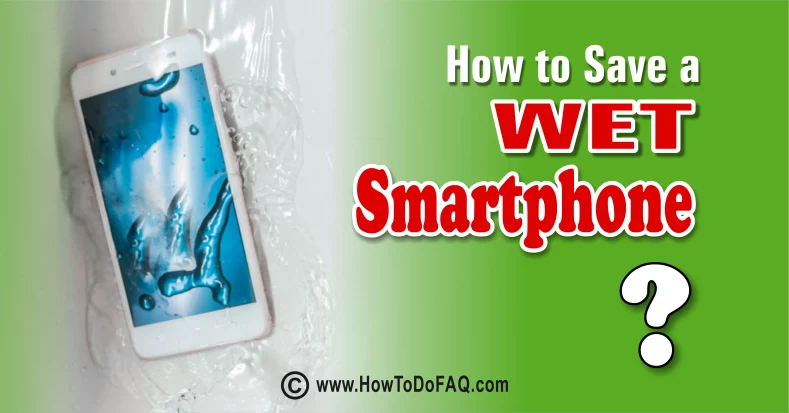Guide to Save a Wet Smartphone
One is to emphasize that smartphones have already become an important part of the modern digitalized world. Today, people use them to communicate, get information, study, work, navigate, and have fun. However, many accidents may occur with these small, but an important device, and one of the most frequent causes is drowning a smartphone in water. It can be the toilet, sink, pool, or puddle, but if one does not follow specific steps, it will always be treated as destroyed or damaged. At the same time, if one tries to follow the recommendations timely and correctly, the possibility of saving a wet smartphone drastically increases. The present guide will help investigate various methods and steps to succeed.
First Things to Do to Save a Wet Smartphone:
- Retrieve the Device from the Water Source: The phone that has taken a bath should be removed from the water as soon as it is practically possible. However, if the device has been charging when getting wet, the user should cut the power and get the device out of the charging cable.
- Turn off the Phone: The principal advice for retrieving a wet smartphone is to power it off. This will allow possible short circuits and harm of other internal parts.
- Dry the Phone Exterior: Use a clean cloth or towel to eliminate additional water from the smartphone’s body. Do not do that by shaking the device violently since the moisture will get into its circuits even more.
- Remove external Additions:: If the smart gadget is protected with a case and screen cover, do not waste time and take them off. It will allow the device to dry faster and more efficiently.
- Do Not Raise the Temperature: Never attempt to dry a smartphone with a hair drier, heater or in a microwave as high temperature may spoil the internal lightweight structure.
- Choose a Drying Method: Different methods to help repair a wet cellphone’s damage will be talked about below.
Drying Methods to Save a Wet Smartphone:
1. Rice Method:
- How it Works: The waterlogged phone is transferred into a container filled in with uncooked rice. Rice has the effect of a desiccant, meaning that it takes water from a moist environment or surface.
- Steps:
- Fill a bowl to a height of 2 inches with uncooked rice.
- Place the wet phone into the rice.
- Close the container and placeit in a quiet place for not lessthan 24 to 48 hours.
- After that, remove thephone and try topower it.
- Pros: Rice is easily accessible and inexpensive. It’s also a well-known DIY method for drying wet electronics.
- Cons: It may even be ineffective compared to some specialized drying agents, which can save your devices in a similar situation. Meanwhile, there is a possibility of rice particles getting stuck in your phone’s ports or crevices. In order to avoid this negative side, you can place the phone in rice after dropping it first inside a women’s sock which has a thin texture.
2. Silica Gel Method:
- How it Works: Silica gel packets, which canbe found with many prepackaged products such as electronic s and shoes, are highly absorbent and can effectively wick the moisture awayfrom the smartphone. Consequently, it is also one ofthe most favored materials that canbe utilized to save a wet smartphone.
- Steps:
- Place your wet smartphone in a sealable plastic bag.
- Add several packets of silica gel to the bag.
- Seal the bag tightly and leave it removed for 24- to 48-hour.
- After the drying period, remove the phone and check its functionality.
- Pros: This product is specifically created for “moisture absorption” and it may work even better than rice. It will also be less messy.
- Cons: Not everyone has a silica gel bags and a packet is one of the most admissible sources to be used, it may be also costly to use a sufficient quantity of those.
3. Desiccant Packs Method:
- How it Works: Like silica gel, desiccant packs are designed toabsorb moisture and friction could be agood option to dry out ahumid smartphone.
- Steps:
- Get your wet smartphone in aziplock plasticbag.
- Add several desiccant packs ,to the bag .
- Seal the bag tightly ,and leave it without disturbance for between 24 and 48 hours .
- Finally,take your phone off and check if it is functional .
- Pros: Those packs are designed to absorb moisture and they might work better than rice or silica gel.
- Cons: As with silica gel, it may be difficult and relatively expensive for some to acquire a sufficient amount of desiccant packs.
4. Air Drying Method:
- How it Works: This method involves the process of letting the smartphone dry with the help of air by itself.
- Steps:
- Firstly, we will have to remove the battery if at all the phone comprises of a removable battery. Sometimes few modern smartphones do not have the option of removing the battery as it is a non-removable battery.
- Next, we just have to put the smartphone at a place where the air is more with the help of direct ventilation.
- Give it at most 48-72 hours to get dry.
- And finally, after the completing of drying process, just insert the battery back if had removed and power it to ensure it is turned on.
- Pros: It is the simplest process and incurs low cost.
- Cons: Sometimes it takes much compared to others and when we are trying to dry with air drying method dirt may set on the wet parts.
■++



